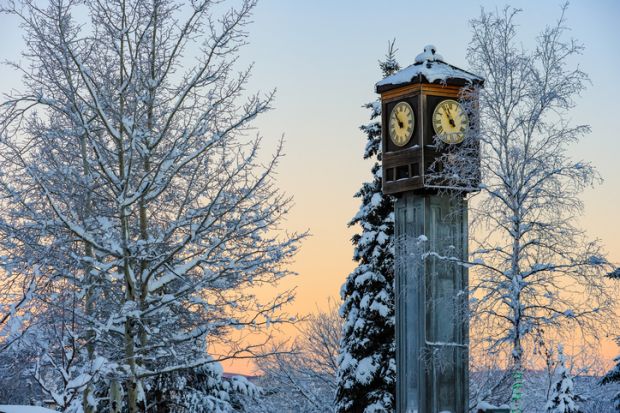The University of Alaska system is celebrating a rebound from the depths of its severe pre-Covid budget cuts, though with doubts that it can now halt state-wide losses of top talent from a remote and fleeing population.
Among the highlights being touted this year, the three-campus system is reporting a 4 per cent gain in enrolment, after five years of declines. State support for the system also climbed by $47 million (£38 million) in the just-concluded budget year, after $55 million in cuts from 2019 to 2022.
Such numbers suggest key reversals from 2019, when Alaska’s Republican governor, Michael Dunleavy – in the months just before the pandemic hit – ordered a 41 per cent cut in state support for the system, before agreeing under political pressure to lessen the pain by about half.
“Students are responding to the increased stability and increase in quality programme offerings across our system,” the system’s president since 2020, Pat Pitney, said in a statement outlining the recent signs of revival.
Yet both university leaders and faculty acknowledged that their system in the nation’s most sparsely populated US state remains under great stress. While this year’s 4 per cent gain leaves the University of Alaska with about 18,000 students, that’s down from nearly 27,000 in 2018.
And the underlying challenges aren’t getting any better in the far-flung northern state, where the population of about 740,000 has seen 10 straight years of more people leaving than arriving.
Aside from a few private religious colleges, the University of Alaska system provides nearly the only higher education option across a land mass bigger than all but 15 countries. And Ms Pitney has been outlining the stakes the state faces by noting data showing that if a high school graduate leaves Alaska for college, there’s only a 25 per cent chance that person will return.
An especially alarming indicator is the Alaska performance scholarship, a general state-funded award of up to $4,755 a year. The percentage of Alaska students in the top tier of the scholarship’s eligibility who elect to stay in-state to collect the money has declined to 22 per cent, from 39 per cent in 2016.
The Dunleavy cuts of 2019 led to the elimination of about 40 academic programmes across the University of Alaska system. The scars of that move are still visible today, said Mara Bacsujlaky, a long-time assistant professor of extension at University of Alaska Fairbanks campus who quit in June, frustrated by the downsizing and chronic mismanagement.
UAF is now “a ghost of itself – it is depressing as hell: half our buildings are empty, we hardly have students”, Dr Bacsujlaky said. “They can say enrolment is up, but it is not anything like vibrant.”
Such problems could be found elsewhere in US higher education as partisan interests attack higher education, Dr Bacsujlaky acknowledged. The tragedy was unique to Alaska, however, for at least a couple of reasons, she suggested.
One was that those in the local population who intended to stay in Alaska – especially indigenous people – lacked postsecondary alternatives. The other, she noted, was that the University of Alaska Fairbanks, as the state’s main research institution, had offered unparalleled opportunities in Arctic-focused science, for fields that included engineering, climate and local cultures, that might now get lost.
A big part of Alaska’s problem, she and others said, was that the state enjoyed a wealth of oil revenue but had failed to figure out how to budget it in ways that avoided damaging year-to-year swings in educational investment.
“And we are faltering,” Dr Bacsujlaky said. “It’s probably the worst it’s ever been.”
Register to continue
Why register?
- Registration is free and only takes a moment
- Once registered, you can read 3 articles a month
- Sign up for our newsletter
Subscribe
Or subscribe for unlimited access to:
- Unlimited access to news, views, insights & reviews
- Digital editions
- Digital access to THE’s university and college rankings analysis
Already registered or a current subscriber? Login








